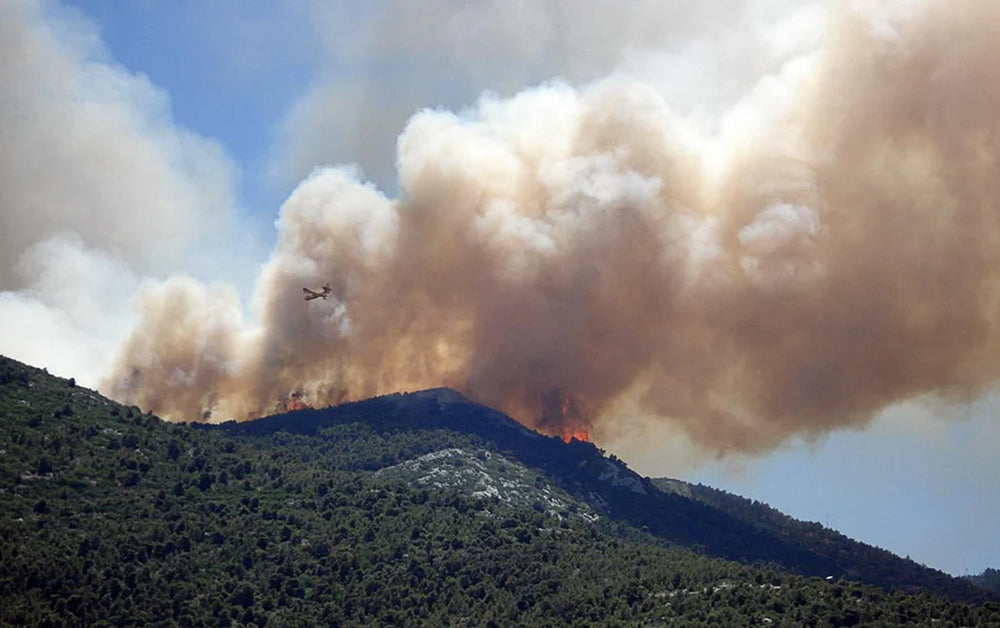Wildfires have become an all-too-common occurrence in many parts of the United States, particularly in states like California, Oregon, and Colorado. These fires, often fueled by dry conditions and high winds, not only pose a significant threat to life and property but also lead to widespread smoke that affects people in nearby cities and towns.
For homeowners, this can result in unexpected and frequent triggers of smoke alarms inside their homes. While these alarms are designed to keep us safe in case of fire, many residents find themselves wondering:
How does smoke from a wildfire miles away set off my smoke detectors?
Wildfire Smoke and Its Characteristics
Firstly, wildfire smoke contains various components, including fine particulate matter (PM2.5), ash, and gases. These particles can travel long distances and impact indoor air quality—even in homes far from the fire sources.
- Smoke Particles (PM2.5): These tiny particles penetrate deep into the lungs, causing respiratory issues and infiltrating buildings through open windows or ventilation systems, potentially affecting smoke detectors.
- Ash: Larger than smoke particles, ash can enter through ventilation systems or windows and accumulate in smoke detectors, blocking sensors and reducing sensitivity.
- Gases and Chemicals: Wildfire smoke releases gases like carbon monoxide, carbon dioxide, and VOCs. While they don’t typically trigger alarms, they degrade air quality and pose health risks.
How Smoke Detectors Are Affected
1. How Smoke Gets Indoors
Smoke can enter a home through many avenues: open doors, windows, HVAC systems, or bathroom/kitchen exhaust fans. Without proper filtration, wildfire smoke can accumulate indoors and activate smoke detectors, even when no fire is present.
2. Smoke Source Confusion
Smoke detectors are designed to detect particles—not determine the source. This means your alarm can go off because of wildfire smoke that entered your home, not because of a fire inside.
Understanding this distinction helps explain why false alarms happen during fire season.
Ionization vs. Photoelectric Detectors: What Works Best?
- Ionization Smoke Detectors
These are more sensitive to small, fast-moving smoke particles, typically of flaming fires. However, wildfire smoke includes larger and slower-moving particles, making ionization detectors less effective in such scenarios.
- Photoelectric Smoke Detectors
Photoelectric detectors use light sensors and are more responsive to larger particles from smoldering fires and wildfire smoke. These detectors are generally better suited to respond to wildfire conditions.
False Alarms: Why They Happen
One of the most common issues during wildfire season is a spike in false smoke alarm activations.
- Smoke ≠ Fire: Detectors don't distinguish between types of smoke—they simply respond to particle concentration.
- Wild Dispersal: Wildfire smoke can travel hundreds of miles, entering homes far from the fire. Both types of detectors—ionization and photoelectric—can be triggered depending on particle concentration.
- Ash Accumulation: Ash can clog or coat sensors, reducing detector sensitivity, increasing false alarms, or even preventing proper activation when a real fire occurs.
How to Manage Smoke Detectors During Wildfire Season
Wildfire smoke can challenge the effectiveness of smoke detectors. Here’s how to keep them functioning properly and minimize false alarms during wildfire season:
1. Regularly Check and Maintain Detectors
-
- Test alarms: Press the test button regularly.
- Clean detectors: Remove dust and ash with a vacuum or compressed air.
- Replace batteries: Change batteries at least once a year, especially before wildfire season.
2. Temporarily Isolate Detectors
During intense wildfire smoke, disable or choose another place for detectors temporarily to avoid constant false alarms. This can be done without affecting other interconnected detectors in the house.
3. Use Additional Monitoring Devices
-
- Air Quality Monitors: Track indoor air quality and detect harmful particles like PM2.5.
- PM2.5 Sensors: These can help identify when smoke particles infiltrate your home, even if smoke detectors don’t trigger.
Conclusion
As wildfires become more common, protecting your home goes beyond just sealing windows—it means ensuring your smoke alarms remain reliable and responsive.
At Siterwell, we recommend using photoelectric smoke detectors and regular maintenance to minimize false alarms during wildfire season. For even more peace of mind, consider pairing your detector with PM2.5 air quality monitors.
Your safety starts with awareness—and the right tools.



